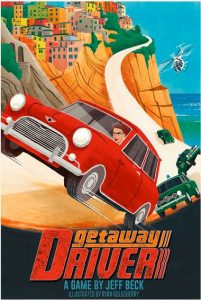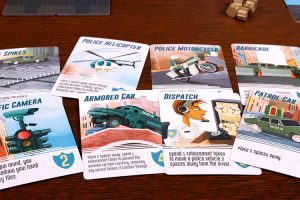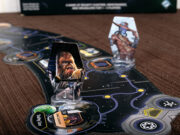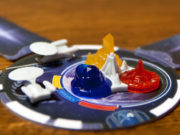 If there is an iconic scene you are sure to find in any heist movie, it’s the “chase scene”. A car flying down roads at high speeds doing impossible stunts while a cadre of police cars zip after them, sirens blaring. It’s always exciting and usually one of my favorite parts of the movie.
If there is an iconic scene you are sure to find in any heist movie, it’s the “chase scene”. A car flying down roads at high speeds doing impossible stunts while a cadre of police cars zip after them, sirens blaring. It’s always exciting and usually one of my favorite parts of the movie.
Today we are going to be looking at Getaway Driver, a two-player, asymmetrical game that seeks to recreate that experience on your tabletop.
Gameplay Overview:
Despite the overly dense rulebook, Getaway Driver actually plays fairly smoothly. One player takes on the role of the escape car, while the other commands the police force.
Each round in Getaway Driver starts with the Police player placing new tiles in the city. For every open space adjacent to the driver’s tile, the police player places a face down city tile (the police may peek at the tile first).

Then the driver must move their car either forward, left, or right. If the driver wants to be cautious, they can spend time scouting a tile first, but that increases the pursuit meter. Once a driver moves onto a tile, it’s revealed and, depending on the status of the tile, one of three things could happen:
- The tile is Green: the driver moves onto it.
- The Tile is Red: It’s a hazard, the driver must either play a card from their hand with a matching icon or back out of the tile to where they were. If the police were following the driver, the police car crashes.
- The Tile is Yellow: The driver chooses to make the tile either green or red (as above)
Some tiles also feature an enforcement amount (1-3 tokens) and the police player collects those tokens to their supply once revealed.
Then the police player gets to take their turn, moving cars, purchasing upgrades with enforcement tokens, and generally trying to position their vehicles to corner the driver. If the police player ends their turn with a car sharing a tile with the driver, the enforcement meter is raised one. If not, it’s lowered one. Then a new round begins.
Turns go by in this manner until either the police meter has reached level 3 or the driver has no legal moves, in which case the police player wins. The driver wins if the police player needs to place a tile and there are no more available.

Game Experience:
Before I get into the gameplay, I want to give some credit to the excellent production values of the game. I’ve always been a fan of artist Ryan Goldsberry’s style and it comes through in spades here. I also appreciated how all the tiles line up, so no matter what tile you put down, it won’t create any weird looking intersections. The game also comes with some scenery pieces (which I never actually used) and even stickers for the wooden tokens. I actually gave up trying to put the stickers on the pieces, as my sausage fingers weren’t dexterous enough to stick them on. But the wooden tokens looked fine without stickers to me.

For the actual gameplay, I enjoyed the asymmetrical nature of the game. The cat and mouse interplay between the two sides offered a great dynamic that has the driver trying to make decisions on imperfect information, while the police need to be thinking three steps ahead of the driver. What that does is give players a lot to think about during the game and no decisions are easy.
The driver needs to not only decide the best time to use their limited hand of 5 cards, but also will set the pace of the chase. The driver can easily loop back around and drive on faceup city tiles they know are safe. However, in doing so, they won’t be putting any new tiles down, which is what they need to do to win the game. So, there is a bit of resource management here as the driver must balance moving the game forward, with keeping cards available for just the right moment.
And then there is the police player who has a wealth of options to throw at the driver. Not only can they have up to three police cruisers in play trying to trap the driver, but they also can have armored cars, helicopters, barricades, and tire spikes (among others). This gives the police player a lot of flexibility with how to spend their resources. Yet those tokens are also limited. Spend them on the wrong thing and you might be wishing for them back. And capturing that driver is much harder than it seems. If the driver moves onto a red light tile, they can always back out. If the police follow them onto that tile, they crash!

Overall, Getaway Driver does a great job of using its theme to create an interesting and dynamic game. The one thing I wish was better though was the pacing of the game. This feels a like a game that should have fast and furious action. A game you can throw on the table and turns will fly by quickly as cars race throughout the city causing mayhem. Yet it’s not. It a slow, ponderous game more akin to a chess match than a game of Hungry Hungry Hippos. While I did enjoy the game, I feel like it has a hard time getting out of the way of its own rules sometimes.
And nowhere is that true more than with the rulebook. To put it bluntly, the rulebook in Getaway Driver is pretty awful. I feel like it took a page out of Batman: Gotham City Chronicles with an overly dense, wordy rulebook that could have been organized way better. For my first play, I gave up trying to learn the game and ended up watching a video from the publisher. While all the rules are there, it’s just not very intuitive as a learning tool.
Final Thoughts:
While I do like Getaway Driver, I do find myself wishing that the game was a bit more streamlined. This isn’t really a game where you can drop it down on the table and watch the action unfold. It’s a thinky, cat and mouse battle between the cops and the driver. There are definitely hard decisions that need to be made by both players, and all our games have come down to the wire, which is a testament to its good design. It feels thematic in every way other than pacing. Overall, Getaway Driver is a good game that definitely feels unique. And once you wrap your head around the rules of play, you can have a lot of fun with this one.
Final Score: 3.5 Stars – A game that uses its theme almost perfectly but could use a little bit faster pacing and a much better rulebook.
 Hits:
Hits:
• Excellent use of its theme
• Great production values
• Fun asymmetrical gameplay that flows well
• Lots of interesting decisions to make
Misses:
• Rulebook could be way better
• Wish the pacing was faster























